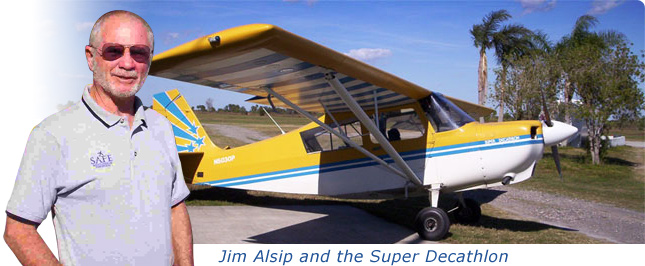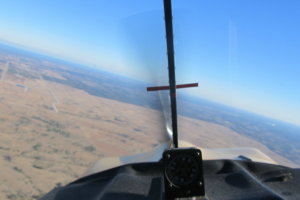Greetings my flying friends
This Hangar Talk is the second in a series discussing my Top Ten Best Stick and Rudder Habits. My list is presented in no particular order; however, recognition and interpretation of the sight picture should be near the top of any list depicting airmanship skills. Pilots know sight picture basics, but some pilots find certain Key Points allusive during everyday maneuvers such a flying a traffic pattern. Some of those key points are the subject of this month’s Hangar Talk.
Click here to see this month’s feature video: Using the Sight Picture.
Using the Sight Picture for Attitude Information
The sight picture shows pitch: Perhaps the most important element of the sight picture is pitch. It is important because pitch shows effects of using the elevator, the angle of attack flight control.
Side Bar: Angle of attack is a big deal – it causes airplanes to stall, controls their airspeed and makes the airplane turn. It is important to understand that pitch, what the pilot sees, is not the same as angle of attack, what the airplane sees. The two are easily confused and a subject for another Hangar Talk.
Three interesting aspects of pitch as displayed on the sight picture are:
1.At a specific power setting and when trimmed for some airspeed, the sight picture will show a corresponding pitch attitude; and likewise pitching to that sight picture will result in the specific corresponding airspeed. Don’t chase your airspeed.
Key point: Instead, know what your airspeeds look like and fly your sight picture on final approach to landing.
2. Every pilot knows how to transition from climbing to level flight: pitch- power- trim. Correctly stated, the procedure is “pitch for airspeed” and most pilots pitch down. That is a gross mistake when transitioning from climb to level flight at a constant airspeed; for example in a traffic pattern at Vy (best rate of climb). During the climb at Vy the sight picture will show a nose high pitch attitude. When arriving at level flight altitude do not pitch down; instead, hold the pitch, maintain the sight picture because that is what Vy looks like.
Key Point: reduce power, hold a nose high sight picture and then trim to establish level flight at pattern airspeed.·
3. A deadly mistake too often results from not using the sight picture. Airplanes stall for one reason, the pilot applies excessive back pressure to the elevator control. Typically that control input is seen as a small pitching moment in the sight picture. If this pitching moment occurs during a turning maneuver, it becomes problematic, even deadly when the pilot is tempted to look at some ground reference during a turn.
Key point: the sight picture betrayed the inadvertent pull, but the pilot was not looking at the sight picture, and he did not see the impending stall and subsequent loss of control.
The sight picture shows bank angle.
Maintaining a constant bank angle during a maneuver, and that includes level flight, is basic airmanship. I fly with way too many pilots that do not maintain a constant bank during maneuvers. My airplane is aerobatic and does not have any attitude instruments; so when a pilot does not keep the wings level, I must conclude he does not know how to interpret the meaning of that big horizon extending across my entire windscreen.
Key Point: with reference to bank angle, pilots are cautioned to avoid two common mistakes:
1. The yolk is not a steering wheel. Avoid steering your airplane especially during turns. Instead, use ailerons to establish bank then allow horizontal component of lift to push the airplane thru the change of direction.
2. Airplane roll and yaw moments are linked. When a wing lifts (or drops) it is frequently associated with yaw. Instead of aileron rudder would be a correct flight control input.
The sight picture shows yaw.
Yaw, rotation on the airplane’s vertical axis, results from any one of four forces:
1. Pilot induced
2. Drag produced when using the ailerons (adverse yaw)
3. P-factor yaw when climbing or descending due to unequal thrust between ascending and descending blades
4. Gyroscopic yaw, the nose moves left when pushing the stick and moves right when pulling.
Whatever the cause of yaw, it must be controlled. That sounds simple, but it is impossible to do if a pilot does not recognize yaw.
Key Point: the sight picture shows yawing motion, but the pilot must be watching to see it. Watching the ball and “stepping on the ball” is not good advice nor good airmanship. To begin with, if the ball is out of center, stepping on the corresponding rudder is too late. The airplane has already yawed. Good airmanship demands that the pilot watch the sight picture to detect the beginning of a yawing moment and counter it with appropriate and timely rudder. That is fundamental; use the control you need when you need it and as much as you need it.
Using the sight picture is essential to good airmanship. A story I heard supports that good practice. An observer who had an opportunity to fly with Bob Hoover when he was practicing his incredible point rolls wanted to determine how Bob used the rudder during the point roll. After the flight, the observer challenged Bob with the fact that Bob’s control inputs appeared to be inconsistent, they varied with each roll. Bob, the quintessential airman, replied that he never thought much about it. He explained that he simply looked out the windscreen and used the control he needed.
This artice is reprinted by permission from Jim Alsip based on an essay from
www.dylanaviation.com . Dylan Aviation School of Aerobatics and Airmanship is located at (
X58) Indiantown Airport, Indiantown, Florida.
NOTICE
I. The comments and suggestions contained in this article are based on the general observations of the author. As such, no endorsement or guarantee of any product mentioned herein is intended. In all cases of conflict between manufacturer's instructions and contents herein, the former should be adhered to and followed.
II. The author, IAC & EAA present this material for reference only, and expressly deny any and all liability, express or implied, which may result from the use of the suggestions or statements contained herein by any party. Any such party using the suggestions or statements herein, does so at his own risk and without recourse.
III. As a condition of use of the information contained herein, and in consideration of the furnishing thereof, the reader, for himself and his administrators, executors, heirs and assigns, agrees to forever hold harmless and defined the author, IAC and/or the EAA (including any members, officers, directors, agents or employees thereof) from any and all liability or damage of any nature regardless of cause, to reader or any third person, which may result from the use of said materials.)



